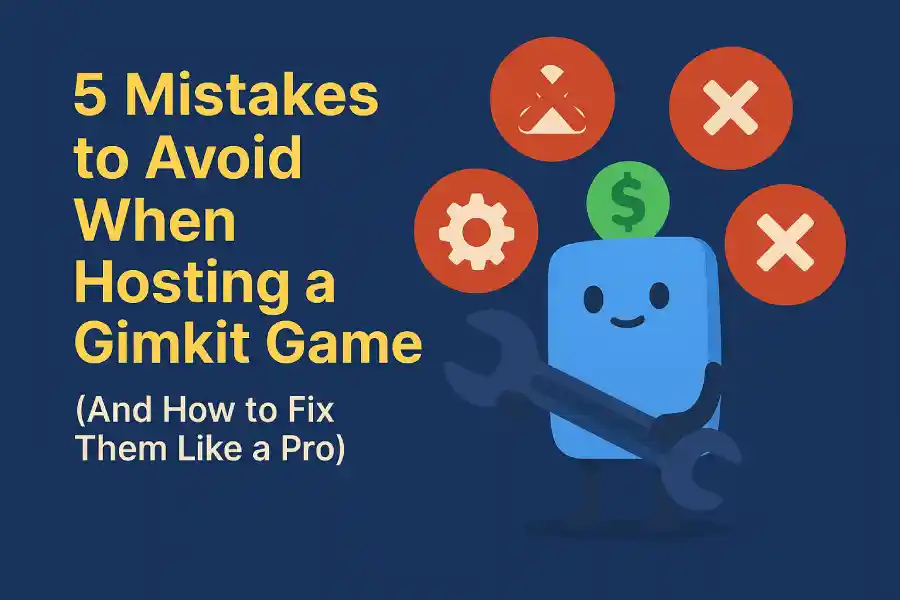
Let me tell you a little secret: the first time I hosted a Gimkit game, I thought I nailed it. Spoiler alert—I didn’t.
Half the students were lost, the questions looped endlessly, and I hadn’t even set a time limit. Chaos. Pure chaos.
Hosting a Gimkit game can either make you look like the cool, tech-savvy teacher—or it can turn into digital mayhem. But don’t sweat it. Whether you’re brand new or just looking to sharpen your hosting game, here are 5 common Gimkit host mistakes you’ll want to dodge—and exactly how to do it.
Pro Tip: If you haven’t explored how to create your own game yet, check out this simple guide to creating a Kit in Gimkit.
1. Not Testing the Game Beforehand
Been there. Done that. Learned the hard way.
Starting a Gimkit session without a quick test drive is like showing up to karaoke night without checking if the mic works. Suddenly, you’re fumbling, the students are confused, and you’re praying the tech gods show mercy.
Why It Happens:
- You’re short on time.
- You assume “Play” means “it’ll work fine.”
The Fix:
- Run a trial with a colleague or friend.
- Test the game mode, timer, questions, and joining process.
- Don’t forget to try it from a student’s perspective too.
Need help hosting? Here’s a step-by-step Gimkit Host Guide to walk you through.
Overcomplicating the Game Modes
“Let’s turn on team mode, plus random power-ups, with the infinity loop, and some ghost sabotage!”
— Me, trying to be cool… and failing miserably.
Sometimes less is more. Throwing every single option at your students doesn’t make the game fun—it just makes it messy.
Why It Happens:
- You want to make it “cool.”
- You don’t fully understand what each setting does.
The Fix:
- Stick to 1-2 core settings at first.
- Use “Classic” or “Team Mode” for beginners.
- Gradually experiment once your class is comfortable.
3. Ignoring Feedback from Students
After my second Gimkit attempt, a student told me:
“It was fun, but we didn’t really learn anything.”
Ouch—but honest.
Why Feedback Matters:
- Your students are your beta testers.
- They know what’s working (and what’s just bells and whistles).
The Fix:
- Ask what they liked and didn’t.
- Use a quick exit ticket or Google Form post-game.
- Adjust your Kit, time limit, and rewards accordingly.
Quote from a real educator:
“Student feedback helped me realize some kids just didn’t understand the mechanics. Simplifying things made a huge difference.”
— Sarah M., 6th Grade Science Teacher
4. Not Monitoring the Game Live
One time, I walked away to refill my coffee and came back to a virtual warzone. Kids were hoarding points, and one figured out how to exploit the respawn setting.
Why It Happens:
- You think Gimkit runs itself.
- You assume older students “get it.”
The Fix:
- Actively watch the leaderboard and chat.
- Use host tools like “Kick Player” or “Pause Game” if needed.
- Walk around the room (or monitor virtually) to check participation.
| Do This | Not This |
| Stay engaged in-game | Walk away mid-session |
| Answer student questions | Let them figure it out |
| Adapt on the fly | Stick to script rigidly |
5. Not Setting Clear Learning Objectives
No one wants to hear “Let’s play this quiz thing” without context. Students engage more when they know why they’re doing it.
The Fix:
Before starting the game, explain:
- What they’ll learn
- What to focus on
- How it connects to the lesson
Example:
“This Gimkit is a review of key Civil War events. Watch out for trick questions and focus on dates and battles!”
Bonus: Top 5 FAQs About Hosting a Gimkit Game
To help you go from “meh” to “master,” here are answers to questions I get all the time:
How do I host a live Gimkit game?
Go to gimkit.com, click “Kits”, select one, and hit “Play Live.” Choose your game mode and share the join code with students.
Can students join without accounts?
Yes! Students just need a game code—no sign-up required.
What settings should I enable when hosting?
Start simple. Enable random names, power-ups off, and set a time limit (5-10 minutes). Adjust from there.
How long should a game be?
5 to 15 minutes is perfect. Long enough to engage, short enough to stay sharp.
What’s the best game mode for engagement?
“Classic” and “Team Mode” are great for most. “Trust No One” is fun for upper grades.
Wrap-Up: Play Smart, Not Hard
Look, mistakes happen—I’ve made every single one of these. But with a little prep, smart choices, and feedback from your players, Gimkit can become one of the best tools in your classroom arsenal.
Want more resources?
- Learn how to create a Kit in Gimkit
- Explore advanced hosting tricks in this Gimkit Host Guide
- Visit gimkit.com for the latest updates and features
Now it’s your turn!
Have you ever made a hosting mistake on Gimkit? Got a funny story or pro tip to share? Drop it in the comments below.



